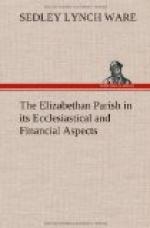In the thirty-one years from 1556-7 to 1587-8 in this parish the recorded wardens’ expenditures had more than doubled. In the first-named year they had been but L8 I2s. 5d.;[253] in the latter year they had swelled to L18 14s 3-1/2d.[254] This characteristic is true of all Elizabethan church budgets, and the writer has seen a number of them.[255] The Wootton churchwardens enter under the year 1600 the following: “Rec. by our Kingale, all things discharged, xij li. xiiij[s]. jd. ob.,” an important sum for the day.[256]
Besides the churchwardens other wardens or gilds sometimes busied themselves with the selling of ale for the benefit of the church. One of these gilds at South Tawton, Devon, records in its accounts for 1564: “We made of our alle and gathering xl l. viijs. viijd."[257]
So important a source of parish income had to be carefully looked after. A church-ale with its attendant festivities for drawing visitors was an important business matter. Accordingly we find the parishioners of St. John’s, Glastonbury, making an order in 1589 “that the churchwardens shall yearly keape ale to the comodeti of the parishe upon payne of xxs. a yere."[258]
In Ashburton, Devon, in 1567 Christopher Wydecomb had to pay 20s. to the wardens “because he refused the office of the drawer of the church ale."[259] At Wing, Bucks, those refusing “to be lorde at Whitsuntyde for the behofe of the church” were fined 35. 4d. apiece.[260] In some places these masters of the revels were called Cuckoo Kings, and the office seems to have gone in rotation like other parish offices.[261]
When invitations had been sent out to surrounding parishes, interparochial courtesy seems to have required the attendance either of the churchwardens or of some other more or less official representatives of the neighboring communities. These representatives carried with them some small contribution made at the expense of their respective parishes (’ale-scot’).[262]




